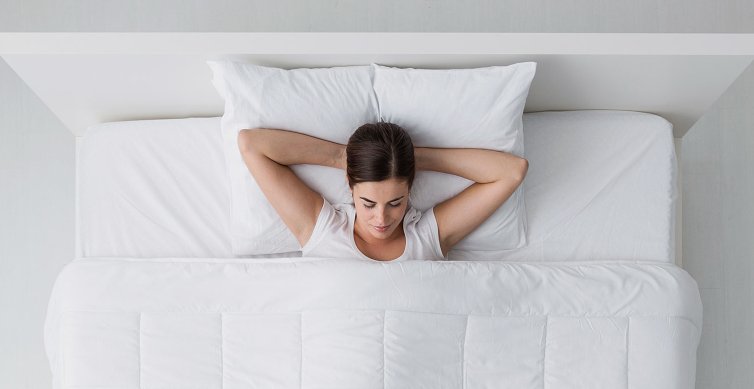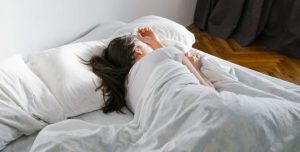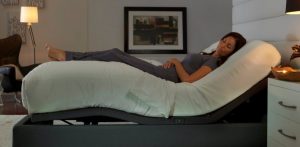Like everybody else, you probably have a favourite sleep position that you stick to for years. But did you know that you can develop permanent sleep wrinkles, depending on the way you choose to sleep?
Side and stomach sleeping are the sleep positions that may cause you to develop permanent sleep wrinkles.
Back sleeping – on the other hand – doesn’t increase your risk of developing sleep wrinkles and is the most effective way to prevent these types of wrinkles.
Why is Supine Position the Best Position to Prevent Sleep Wrinkles?
For those who don’t know; sleeping in the supine position is another way of saying sleeping on the back.
So why is sleeping on the back the best position when it comes to preventing sleep wrinkles?
When you sleep on your back the only external force that your skin is exposed to is gravity [1]. That is to say, nothing compresses or applies pressure to your face when you sleep in the supine position. Besides, no friction occurs between your face and the pillow while you sleep on your back.
In contrast, when you sleep on your side or stomach, one side of your face presses into the pillow or the bed surface for hours at a time until you turn the other way. This prolonged pressure to your face can cause your face to fold and crease.
Over Time Sleep Wrinkles May Become Permanent
If you seldom sleep on your side or belly, you are likely to prevent permanent sleep wrinkles.
However, if your face is buried into the pillow every night due to your sleep position, then sleep wrinkles may become permanent over the years.
Important to note that if you sleep on the same side for years, the side of your face you constantly sleep on is at risk of developing sleep wrinkles.
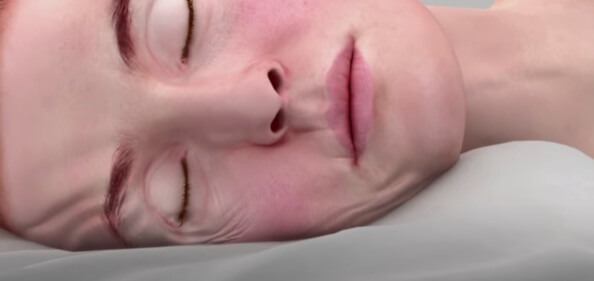
image credit: juverest.com
The vertical lines and creases, seen on the right side of the face in the image, illustrate the sleep creases that can be caused by the compression of the face against the pillow.
If these or similar creases are reinforced every night during sleep, they may get etched into the skin and become permanent over time.
Age Factor in Sleep Wrinkles
Since skin elasticity and extensibility decrease with age, especially middle-aged and elderly people are prone to developing permanent sleep wrinkles [2, 3].
For instance; a child’s skin swiftly returns to its original state after waking up even if the face gets wrinkled during sleep; because the quality and production of components like collagen and elastin are high in the skin of children [4, 5, 6].
In a study, published in the Aesthetic Surgery Journal, researchers explain this situation as: ” Sleep wrinkles disappear immediately on younger skin, but will eventually become permanent from constant compression and decreased skin elasticity with age,”.
Research Confirms: Sleeping Face Up Prevents Sleep Wrinkles
Dermatologists have been familiar with the concept of “sleep wrinkles ” for a considerable amount of time.
To date, sleep wrinkles have been investigated in various studies. It is believed that Dr Samuel J. Stegman is the first one who scientifically defined the features of sleep wrinkles [1, 7]
In his article, published in the American Journal of Cosmetic Surgery in 1987, Dr Stegman shared his observations, thoughts and findings on sleep creases.
He concluded that sleeping on the back is the most effective way to prevent sleep creases. Though, he was aware of the fact that adapting to back-sleeping can be quite difficult for many side or stomach sleepers.
American dermatologist James E. Fulton et al carried out a study to evaluate Dr Samuel J. Stegman’s findings on sleep wrinkles.
They found similar results and came to the conclusion that in order to prevent sleep lines, a sleep position that prevents the face from pressing against any sleep surface should be preferred, which refers to sleeping on the back.
More recent studies on this topic achieved, more or less, the same results [8, 9].
Briefly, research on this topic shows that sleeping on the back prevents sleep-induced wrinkles whereas sleeping on the belly and side can cause individuals to develop permanent sleep wrinkles in the long run.
Where May Sleep Wrinkles Appear?
Dermatologists and plastic surgeons identified the most common areas where sleep wrinkles tend to occur [1, 8, 9, 10].
Instead of writing the technical names of these areas, illustrating them with an image will be probably more helpful.
The image below shows the areas where you might notice permanent sleep lines on your face if you repeatedly sleep on your side or stomach.
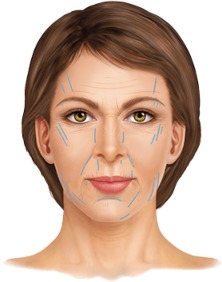
Image credit: juverest.com
What’s more; constantly sleeping on your side or stomach may also cause chest and neck wrinkles, or deepen the existing ones [11].
How to Become a Back-Sleeper
Based on the surveys and studies it is estimated that between 10 to 30% of people prefer sleeping in the supine position [1, 12, 13, 14].
You may want to be a back-sleeper to prevent sleep wrinkles. If so, you should know it may take some time.
Although, it varies from person to person; it is suggested that getting used to a new sleep position takes up to a month [1, 15].
Here are some tips that might help you become a back-sleeper…
- Choose a mattress that properly supports your back
- Place a pillow underneath your knees
- Slightly elevate your head with a pillow (preferably) between 3 and 5 inches thick
- Surround yourself with pillows that will prevent you from changing your position subconsciously
Note: If you are pregnant or suffer from low back pain and sleep apnea, back sleeping may not be suitable for you.
More About Sleep Positions and Sleep Wrinkles
The force that your face is subject to when you sleep on your stomach tends to be higher compared to other sleep positions. Hence, generally, stomach sleeping is indicated as the worst sleep position in terms of sleep wrinkles.
If you can’t give up sleeping on your side or stomach, then consider using a silk or satin pillowcase instead of cotton.
Another way to lower the risk of developing sleep wrinkles is to use specially designed pillows that reduce facial contact with the pillow surface when you sleep on your side.
Are There Ways to Treat Sleep Wrinkles?
Throughout the article, we repeatedly said that back sleeping is the most effective way to prevent sleep wrinkles.
But, what if you already developed sleep wrinkles that do not go away? Are there ways to lessen the appearance of sleep wrinkles or even remove them?
Treatment options for sleep wrinkles are said to be slightly more limited than the treatment options that are available for expression wrinkles [1].
For instance, it is suggested that botox® (Botulinum toxin) can’t be used to treat sleep wrinkles as they are not caused by muscle contraction [1, 16, 17].
Other treatment methods for wrinkles, such as; soft-tissue fillers, face-lift, dermabrasion, laser resurfacing and chemical peels might be effective to help lessen the appearance of sleep wrinkles [1, 18, 19, 20, 21].
Your dermatologist will examine your wrinkles and determine the best treatment method depending on many variables such as your skin type and the depth of the wrinkles.
Conclusion
In this article, we discussed how sleep positions influence the formation of sleep wrinkles. It appears that the most reliable way to prevent sleep wrinkles is to sleep on the back.
If you aren’t accustomed to sleeping on your back, initially it might be hard for you to sleep in this position. Yet, in time you can fully adopt it.
Assess other pros and cons of sleeping on your back, then decide the ideal sleep position for your wellbeing.
Please do not forget that wrinkles are inevitable and the most effective way to delay their formation or lessen their appearance is to work with a dermatologist.
If possible, ALWAYS work with your dermatologist to have healthy skin.
